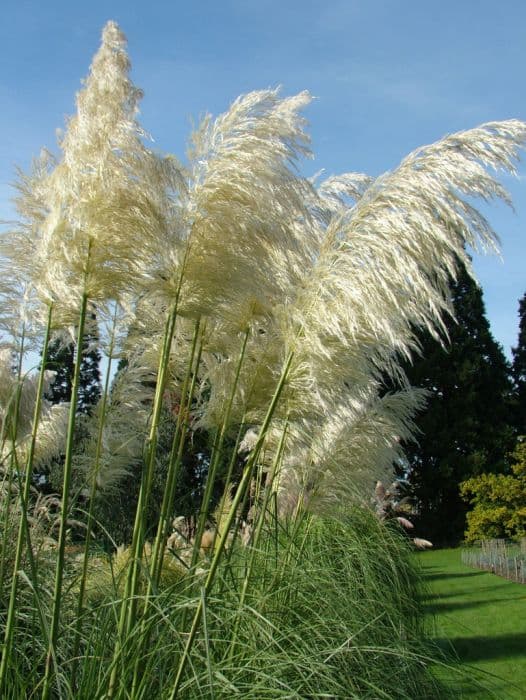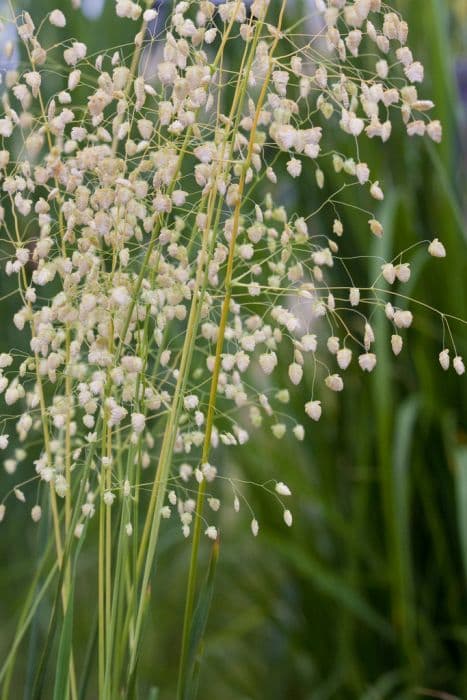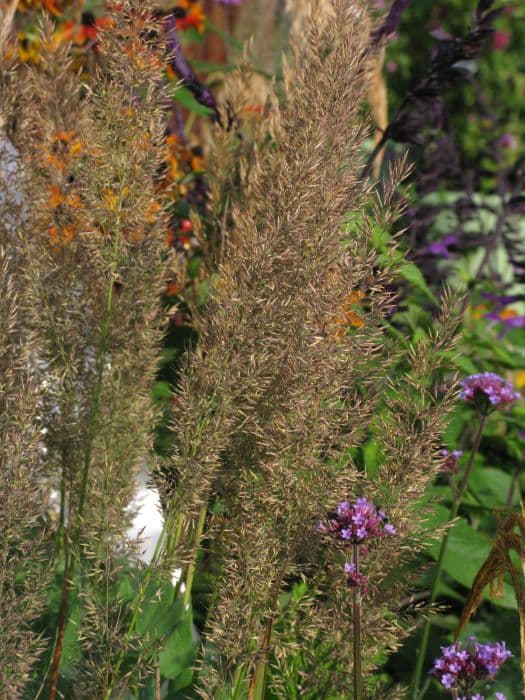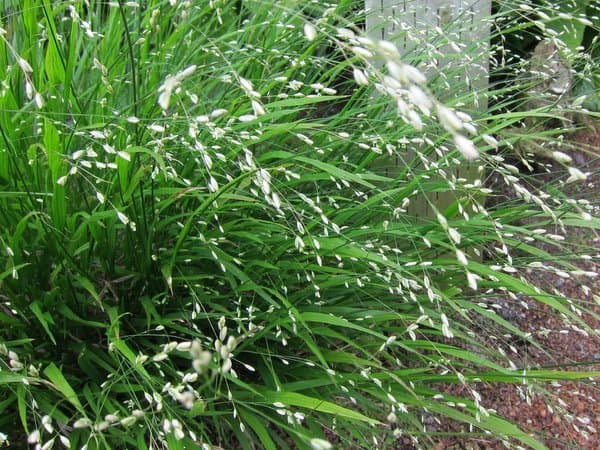Pampas Grass Cortaderia selloana 'Monstrosa'

ABOUT
Commonly known as Pampas Grass, 'Monstrosa' is a visually striking ornamental grass. With its graceful, arching foliage, the leaves create a dense and lush fountain-like clump. The leaves themselves have a razor-sharp edge and are often a blue-green hue, adding a touch of cool color to the landscape. Most noticeable are the feathery plumes which it produces abundantly. These plumes are showy, often fluffy, and can range in color from silvery white to sandy beige. They emerge above the foliage like soft spears, adding a texture that can catch the light and move in the breeze. This combination of bold plumes and fine leaves creates a dramatic visual contrast that's distinct to this variety of Pampas Grass. Though size is not detailed here, its overall form is impressively full and can make a substantial visual impact in a garden setting.
About this plant
 Names
NamesFamily
Poaceae
Synonyms
Pampas Grass, Giant Pampas Grass, Monstrosa Pampas Grass
Common names
Cortaderia selloana 'Monstrosa'.
 Toxicity
ToxicityTo humans
Pampas Grass, which is the most common name for Cortaderia selloana 'Monstrosa', is not considered highly toxic if ingested by humans. However, it can cause mechanical irritation due to its sharp-edged leaves. It is not typically known for its toxicity in terms of poison symptoms from ingestion, but it can cause physical harm due to the sharpness of its leaves and the potential for small cuts or abrasions, which can lead to secondary infections if not properly treated. Care must be taken when handling to avoid injury.
To pets
Pampas Grass, the common name for Cortaderia selloana 'Monstrosa', is not toxic to pets if ingested. It does not contain poisonous substances that would cause symptoms of poisoning in pets. However, similar to its effects on humans, the sharp leaves can cause cuts or irritation to the mouth and digestive tract of pets if ingested or even just chewed on. It is important to prevent pets from having access to the plant to avoid the risk of mechanical injury.
 Characteristics
CharacteristicsLife cycle
Perennials
Foliage type
Evergreen
Color of leaves
Green
Flower color
Varies
Height
8 feet (2.4 meters)
Spread
6 feet (1.8 meters)
Plant type
Grass
Hardiness zones
8
Native area
South America
Benefits
 General Benefits
General Benefits- Ornamental Appeal: Adds visual interest to gardens with its large, feathery plumes and grassy foliage.
- Drought Tolerance: Once established, it requires minimal watering, making it suitable for xeriscaping and drought-prone areas.
- Low Maintenance: Requires little care beyond occasional trimming to maintain shape and remove old foliage.
- Windbreak: Can act as a natural windbreak due to its height and dense growth.
- Erosion Control: Its root system helps stabilize soil, preventing erosion on slopes and banks.
- Privacy Screen: Grows tall and dense, providing a natural privacy screen for homes and gardens.
- Habitat for Wildlife: Attracts birds that use it for shelter and nesting.
- Adaptability: Thrives in a variety of soil types as long as they are well-draining.
- Seasonal Interest: Offers year-round interest, but particularly striking when it flowers in late summer to fall.
- Cold Hardy: Capable of withstanding cooler climates and is hardy in many regions.
 Medical Properties
Medical PropertiesThis plant is not used for medical purposes.
 Air-purifying Qualities
Air-purifying QualitiesThis plant is not specifically known for air purifying qualities.
 Other Uses
Other Uses- Privacy Screens: Pampas Grass can be planted in rows to create natural privacy screens for property lines or to conceal unsightly areas.
- Erosion Control: Its extensive root system can help stabilize soil on slopes and prevent erosion.
- Ornamental Displays: Dried pampas grass plumes are used for large floral arrangements and ornamental decoration in homes and public spaces.
- Sound Barrier: When planted in mass, the dense foliage of pampas grass can help reduce noise pollution.
- Theme Gardens: Pampas Grass is often used in xeriscaping and seaside-themed gardens for its drought tolerance and coastal look.
- Wind Breaks: Tall varieties of pampas grass can act as windbreaks, protecting smaller plants and reducing wind speed in gardens.
- Photo Shoot Prop: Its tall and striking appearance makes it a popular choice as a backdrop for photo shoots, particularly weddings.
- Craft Material: The plumes can be used in making wreaths, dream catchers, and other crafts for their texture and aesthetic appeal.
- Frozen Landscapes: In cold regions, the frosted plumes of pampas grass can add beauty to the winter garden landscape.
- Seasonal Displays: During the fall, pampas grass can be incorporated into autumnal displays, combining its plumes with pumpkins and other harvest-themed decorations.
Interesting Facts
 Feng Shui
Feng ShuiThe plant Pampas Grass is not used in Feng Shui practice.
 Zodiac Sign Compitability
Zodiac Sign CompitabilityPampas Grass is not used in astrology practice.
 Plant Symbolism
Plant Symbolism- Beauty and Pride: Commonly known as Pampas Grass, Cortaderia selloana 'Monstrosa' is often associated with beauty due to its tall, elegant plumes. Its commanding presence in a landscape can symbolize pride and self-assuredness.
- Fertility and Abundance: With its dense tufts of feathery flower heads, Pampas Grass can symbolize fertility and abundance, reminiscent of a bountiful harvest or flourishing growth.
- Wealth and Luxury: Pampas Grass is sometimes used in ornamental displays and luxury home decor, signifying wealth, opulence, and a sense of extravagance.
- Strength and Endurance: As a hardy plant that can withstand many environments, Pampas Grass represents strength and the ability to endure challenging conditions.
- Softness and Comfort: The textures of its fluffy plumes are evocative of softness and comfort, much like a feather, and can symbolize gentleness and a soothing presence.
 Water
WaterPampas Grass prefers to be watered deeply to ensure moisture reaches the roots, and the frequency depends on weather conditions and soil moisture. Typically, watering once every two weeks with around 2 gallons per plant should suffice, adjusting for precipitation and temperature. During hot, dry spells, you might need to water once a week, whereas in cooler or wetter conditions, less frequent watering is necessary. It's important to allow the soil to dry out between waterings to prevent root rot. Overwatering can be just as harmful as under-watering for this drought-tolerant species.
 Light
LightPampas Grass thrives in full sunlight for at least 6 hours daily. It should be planted in a spot where it can receive unfiltered, direct sunlight throughout the day. Partial shade can be tolerated, but the grass may not grow as vigorously or produce as many plumes. The best spot offers ample sun exposure with protection from harsh, drying winds if possible.
 Temperature
TemperaturePampas Grass is hardy and can tolerate a range of temperatures but performs best when the climate is between 70°F and 90°F. The minimum temperature it can survive is around 20°F, while the maximum is approximately 100°F. Ideally, place it in a spot where the average temperature falls within the ideal range to ensure optimal growth.
 Pruning
PruningPruning Pampas Grass is essential for maintaining its shape and encouraging healthy growth. Prune in late winter or early spring before new growth begins, cutting the grass down to about a foot above ground level. This annual pruning helps to stimulate the growth of new plumes and also removes any old foliage that's been damaged over the winter. The best time for pruning is just before the plant breaks dormancy.
 Cleaning
CleaningAs needed
 Soil
SoilPampas Grass thrives in well-drained soil with a mix of two parts loam, one part sand or perlite, and one part peat or compost to retain some moisture. The ideal pH range is neutral to slightly acidic, around 6.1 to 7.5.
 Repotting
RepottingPampas Grass, being a large, fast-growing plant, does not typically require frequent repotting. It should be repotted only if it becomes root-bound or if the soil quality deteriorates significantly.
 Humidity & Misting
Humidity & MistingPampas Grass tolerates a wide range of humidity levels but prefers moderate to low humidity. It is quite adaptable and does not require any special humidity adjustments outdoors.
 Suitable locations
Suitable locationsIndoor
Ensure full sun, ample space, and large pot for Pampas Grass.
Outdoor
Choose sunny spot, plant in spring, ensure space for growth.
Hardiness zone
7-11 USDA
 Life cycle
Life cycleThe life of Cortaderia selloana 'Monstrosa', commonly known as Pampas Grass 'Monstrosa', begins with seed germination, which requires well-drained soil and plenty of sunlight. After sprouting, the seedling goes through a vegetative stage, developing long grass-like leaves and forming a dense clump. As the plant matures, it enters the flowering stage, typically in late summer to autumn, producing tall, feathery plumes that can reach several feet in height. After pollination, which is mostly carried out by wind due to the plant's dioecious nature (separate male and female plants), seeds develop and are dispersed by wind or wildlife. Over winter, the plant may die back, especially in colder climates, but it is capable of regenerating from its root system in spring. Throughout its life, Pampas Grass 'Monstrosa' can spread both by seed and vegetatively by its rhizomes, leading to the potential for it to become invasive in some regions.
 Propogation
PropogationPropogation time
Spring-early summer
Pampas grass, specifically the Cortaderia selloana 'Monstrosa', is typically propagated through division, which is best done in late winter to early spring. This method involves taking mature plants and carefully splitting the root ball into smaller sections, making sure that each division has several shoots and a portion of the root system. The divisions should then be replanted immediately and well watered. It's important to use a sharp spade to minimize damage to the roots and to ensure a quick recovery for the new plants. Over time, these divisions will grow into full-sized plants and can similarly be divided again once they become too large or congested.









